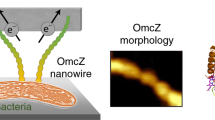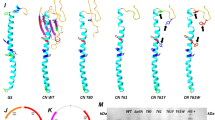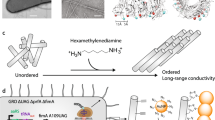Abstract
Electronic nanostructures made from natural amino acids are attractive because of their relatively low cost, facile processing and absence of toxicity1,2,3. However, most materials derived from natural amino acids are electronically insulating1,2,3,4,5,6. Here, we report metallic-like conductivity in films of the bacterium Geobacter sulfurreducens7 and also in pilin nanofilaments (known as microbial nanowires8,9) extracted from these bacteria. These materials have electronic conductivities of ∼5 mS cm−1, which are comparable to those of synthetic metallic nanostructures2. They can also conduct over distances on the centimetre scale, which is thousands of times the size of a bacterium. Moreover, the conductivity of the biofilm can be tuned by regulating gene expression, and also by varying the gate voltage in a transistor configuration. The conductivity of the nanofilaments has a temperature dependence similar to that of a disordered metal, and the conductivity could be increased by processing.
This is a preview of subscription content, access via your institution
Access options
Subscribe to this journal
Receive 12 print issues and online access
$259.00 per year
only $21.58 per issue
Buy this article
- Purchase on Springer Link
- Instant access to full article PDF
Prices may be subject to local taxes which are calculated during checkout




Similar content being viewed by others
References
Hauser, C. & Zhang, S. Nanotechnology: peptides as biological semiconductors. Nature 468, 516–517 (2010).
Skotheim, T. A. & Reynolds, J. R. Handbook of Conducting Polymers (CRC, 2007).
Ashkenasy, N., Horne, W. & Ghadiri, M. Design of self-assembling peptide nanotubes with delocalized electronic states. Small 2, 99–102 (2006).
Dheilly, A. et al. Monitoring of microbial adhesion and biofilm growth using electrochemical impedancemetry. Appl. Microbiol. Biotechnol. 79, 157–164 (2008).
Muñoz-Berbel, X., Muñoz, F. J., Vigués, N. & Mas, J. On-chip impedance measurements to monitor biofilm formation in the drinking water distribution network. Sens. Actuat. B 118, 129–134 (2006).
Herbert-Guillou, D., Tribollet, B., Festy, D. & Kiéné, L. In situ detection and characterization of biofilm in water by electrochemical methods. Electrochim. Acta 45, 1067–1075 (1999).
Yi, H. et al. Selection of a variant of Geobacter sulfurreducens with enhanced capacity for current production in microbial fuel cells. Biosens. Bioelectron. 24, 3498–3503 (2009).
Reguera, G. et al. Extracellular electron transfer via microbial nanowires. Nature 435, 1098–1101 (2005).
Gorby, Y. A. et al. Electrically conductive bacterial nanowires produced by Shewanella oneidensis strain MR-1 and other microorganisms. Proc. Natl Acad. Sci. USA 103, 11358–11363 (2006).
Smart, A. G. Two experiments, two takes on electric bacteria. Phys. Today 63, 18–20 (December 2010).
Heeger, A. J., Sariciftci, N. S. & Namdas, E. B. Semiconducting and Metallic Polymers (Oxford Univ. Press, 2010).
Kaiser, A. Systematic conductivity behaviour in conducting polymers: effects of heterogeneous disorder. Adv. Mater. 13, 927–941 (2001).
Noy, A., Artyukhin, A. & Misra, N. Bionanoelectronics with 1D materials. Mater. Today 12, 22–31 (2009).
Huebsch, N. & Mooney, D. J. Inspiration and application in the evolution of biomaterials. Nature 462, 426–432 (2009).
Yuen, J. et al. Electrochemical doping in electrolyte-gated polymer transistors. J. Am. Chem. Soc. 129, 14367–14371 (2007).
Nevin, K. P. et al. Power output and coulombic efficiencies from biofilms of Geobacter sulfurreducens comparable to mixed community microbial fuel cells. Environ. Microbiol. 10, 2505–2514 (2008).
Reguera, G. et al. Biofilm and nanowire production leads to increased current in Geobacter sulfurreducens fuel cells. Appl. Environ. Microbiol. 72, 7345–7348 (2006).
Lange, U. & Mirsky, V. M. Separated analysis of bulk and contact resistance of conducting polymers: comparison of simultaneous two- and four-point measurements with impedance measurements. J. Electroanal. Chem. 622, 246–251 (2008).
Schwan, H. P. Electrode polarization impedance and measurements in biological materials. Ann. NY Acad. Sci. 148, 191–209 (1968).
Hadziioannou, G. & Van Hutter, P. F. Semiconducting Polymers: Chemistry, Physics, and Engineering 2nd edn, Vol. 2 (Wiley-VCH, 2007).
Kankare, J. & Kupila, E. L. In-situ conductance measurement during electropolymerization. J. Electroanal. Chem. 322, 167–181 (1992).
Lanthier, M., Gregory, K. B. & Lovley, D. R. Growth with high planktonic biomass in Shewanella oneidensis fuel cells. FEMS Microbiol. Lett. 278, 29–35 (2008).
Voordeckers, J. W., Kim, B.-C., Izallalen, M. & Lovley, D. R. Role of Geobacter sulfurreducens outer surface c-type cytochromes in reduction of soil humic acid and anthraquinone-2,6-disulfonate. Appl. Environ. Microbiol. 76, 2371–2375 (2010).
Dallas, P. et al. Characterization, magnetic and transport properties of polyaniline synthesized through interfacial polymerization. Polymer 48, 3162–3169 (2007).
Abthagir, P. S. & Saraswathi, R. Charge transport and thermal properties of polyindole, polycarbazole and their derivatives. Thermochim. Acta 424, 25–35 (2004).
Lee, K. et al. Metallic transport in polyaniline. Nature 441, 65–68 (2006).
Zotti, G. et al. Potential-driven conductivity of polypyrroles, poly-n-alkylpyrroles, and polythiophenes: role of the pyrrole nh moiety in the doping-charge dependence of conductivity. Chem. Mater. 15, 4642–4650 (2003).
Zotti, G. et al. Conductivity in redox modified conducting polymers. 2. Enhanced redox conductivity in ferrocene-substituted polypyrroles and polythiophenes. Chem. Mater. 7, 2309–2315 (1995).
Lindsay, S. Molecular wires and devices: advances and issues. Faraday Discuss. 131, 403–409 (2006).
Chiang, J. C. & MacDiarmid, A. G. ‘Polyaniline’: protonic acid doping of the emeraldine form to the metallic regime. Synth. Metals 13, 193–205 (1986).
Agrell, H., Boschloo, G. & Hagfeldt, A. Conductivity studies of nanostructured TiO2 films permeated with electrolyte. J. Phys. Chem. B 108, 12388–12396 (2004).
Hélaine, S. et al. PilX, a pilus-associated protein essential for bacterial aggregation, is a key to pilus-facilitated attachment of Neisseria meningitidis to human cells. Mol. Microbiol. 55, 65–77 (2005).
Roine, E. et al. Hrp pilus: a hrp-dependent bacterial surface appendage produced by Pseudomonas syringae pv. tomato DC3000. Proc. Natl Acad. Sci. USA 94, 3459–3464 (1997).
Acknowledgements
The authors thank D. Venkataraman, C. Salthouse, M. Aklujkar, J. Nicholson, R. Krotvov, A. Ursache, O. Yavuzcetin and S. Ebru Yalcin for helpful discussions and technical assistance. This research was supported by the Office of Naval Research (grant no. N00014-10-1-0084), the Office of Science (BER), US Department of Energy (award no. DE-SC0004114 and Cooperative Agreement no. DE-FC02-02ER63446 as well as the NSF Center for Hierarchical Manufacturing (grant no. CMMI-0531171)).
Author information
Authors and Affiliations
Contributions
The experiments were designed by N.S.M., K.P.N. and M.T.T., with suggestions from A.E.F., S.F.C, V.M.T. and D.R.L. N.S.M. performed electrical measurements, X-ray studies and AFM imaging of pili preparations. M.V. prepared and TEM-imaged pilin filaments and performed haem staining. N.S.M., M.V., B.C.K., K.I. and T.M. performed protein measurements. B.C.K. generated the BEST strain. C.L. generated the CL-1 strain and performed the peeling and TEM-imaging of biofilms. A.E.F. and J.P.J. carried out the confocal imaging of biofilms. N.S.M., M.T.T. and D.R.L. analysed the data and wrote the manuscript. All authors discussed the results and commented on the manuscript.
Corresponding authors
Ethics declarations
Competing interests
The authors declare no competing financial interests.
Supplementary information
Supplementary information
Supplementary information (PDF 3905 kb)
Rights and permissions
About this article
Cite this article
Malvankar, N., Vargas, M., Nevin, K. et al. Tunable metallic-like conductivity in microbial nanowire networks. Nature Nanotech 6, 573–579 (2011). https://doi.org/10.1038/nnano.2011.119
Received:
Accepted:
Published:
Issue Date:
DOI: https://doi.org/10.1038/nnano.2011.119
This article is cited by
-
The Research on Different Strategies of Fe3O4 Additive Utilization during Semi-Continuous Anaerobic Co-Digestion: A Comparison of Magnetic Separation Recycling and Replenishment without Recycling
Waste and Biomass Valorization (2024)
-
Microbially mediated metal corrosion
Nature Reviews Microbiology (2023)
-
The variation of microorganisms and organics during methane production from lignite under an electric field
Biotechnology Letters (2023)
-
A critical review on nanotechnological advancement in biogas production from organic waste
Biomass Conversion and Biorefinery (2023)
-
An electricity-generating bacterium separated from oil sludge microbial fuel cells and its environmental adaptability
Environmental Science and Pollution Research (2023)



